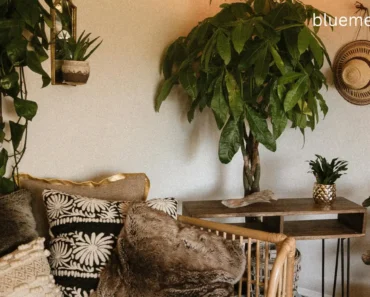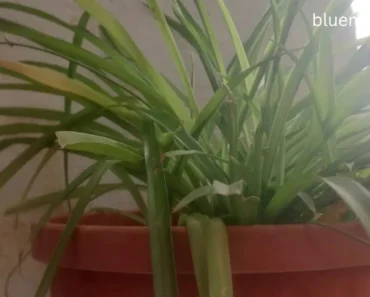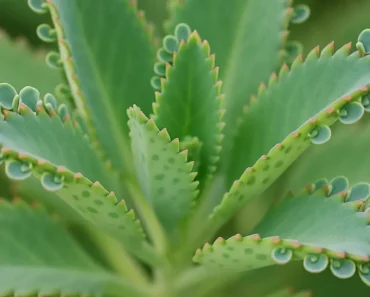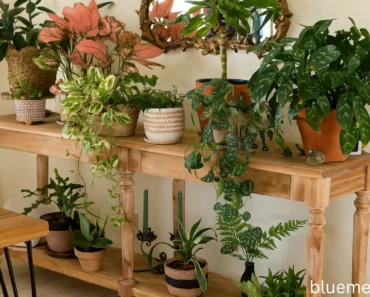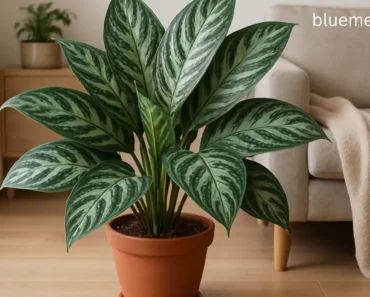What you need to know (the stuff I wish someone told me sooner):
- Feed plants from spring through summer; let them rest in winter.
- Worm compost is like giving your plants a home-cooked meal – gentle and nourishing
- Liquid fertilizer is your monthly plant cocktail – but make it weak, not strong
- When in doubt, do less – I’ve killed way more plants with kindness than neglect
- Don’t feed stressed plants—they can’t use nutrients when unwell.
Okay, so picture this disaster: It’s 2018, and I’m standing in my new Arizona living room surrounded by boxes and 60-something houseplants that I somehow convinced myself I could move across three states. My poor fiddle leaf fig – who I’d named Fernando because why not – was basically giving me the plant equivalent of the middle finger. Yellow leaves everywhere, new growth that looked more like sad little mouse ears, and I swear I could feel him judging me.
I thought I had plant care mastered after 30 years in California, but no one tells you moving plants to a new climate is like asking them to learn a new language overnight. I was still stuck in ‘California mode.’
Table of Contents
The Moment I Realized My Plants Were Basically Prisoners
There I was at 2 AM googling ‘why are my plants dying Arizona’ when it hit me: my plants weren’t just struggling with the move—they were starving.
Think about it this way: if you planted a tomato outside, its roots could wander around a huge area looking for nutrients. It’s like having access to an all-you-can-eat buffet. But my indoor babies? They’re stuck in their little pots with whatever nutrients I give them. It’s more like being trapped in a vending machine that only has three snacks, and once those are gone… well, you’re screwed.
In California, I’d throw some worm compost on my plants once a year and the humidity did the rest. In Arizona, humidity drops below 15%, and air conditioning makes the house even drier—my plants hated it.
I needed to truly learn to feed my plants, not just guess and hope.
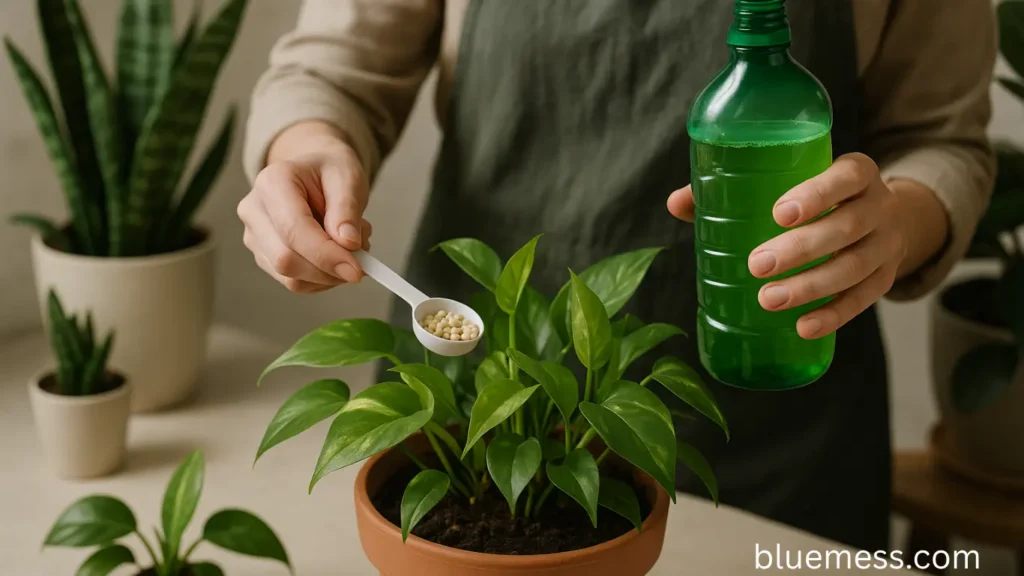
My Three Go-To Feeding Methods (That Won’t Break the Bank or Your Back)
After lots of trial and error, I use three simple, effective methods.
The “Set It and Forget It” Method: Worm Compost
This is my ride-or-die method, and I’m kind of obsessed with it. I get locally made worm compost (yes, that’s a thing, and yes, it’s amazing), mix it with regular compost, and just spread it on top of the soil like I’m frosting a cake.
Why I love this: it’s nearly impossible to screw up. Seriously. You could probably use twice as much as you need and your plants would just be extra happy. It’s like the difference between drinking water and chugging energy drinks – one nourishes you slowly and steadily, the other might make your heart explode.
Every spring, I literally walk around with a bucket (okay, it’s actually an old ice cream container, don’t judge) and sprinkle about an inch on each plant. Takes me maybe an hour for my whole collection, and then I’m done for months. Fernando has been thriving on this stuff.
The “Monthly Cocktail” Method: Liquid Fertilizer
My red watering can has survived countless midnight waterings and fertilizer spills. It’s practically part of the family.
Once a month during growing season, I mix up some liquid fertilizer—at about half the recommended amount. Those bottle instructions are like cereal serving sizes—totally unrealistic. Your plants want a gentle spritz, not a protein shake.
I learned this the hard way. I followed bottle instructions exactly and burned half my collection before realizing less is more.
The “For Busy People” Method: Granular Stuff
Okay, full disclosure: I haven’t gone crazy experimenting with granular fertilizers because the first two methods work so well for me. But I have friends who swear by them, especially if you travel a lot or just have a crazy schedule.
You basically sprinkle these little pellets on the soil, water normally, and they slowly release nutrients over time. It’s like setting up autopay for your plants’ meals. Some people love Osmocote, others go for more organic options. Whatever floats your boat.
Timing is Everything (And I Mean Everything)
Here’s something that blew my mind when I first learned it: your plants actually want to rest in winter. Like, they’re not just being dramatic – they’re biologically programmed to chill out when the days get shorter and cooler.
I stop fertilizing completely from mid-October through February. At first, this felt wrong, but in nature, plants don’t get a steady stream of nutrients year-round. Winter is rest time.
The magic happens around mid-February when I start seeing tiny new leaves popping up. That’s when I know they’re waking up and ready for breakfast again. It’s like they’re stretching and saying, “Okay, I’m ready to grow now!”
Living in Arizona, we get this ridiculously long growing season because the sun never really goes away (sometimes I wish it would, but that’s another story). If you’re somewhere with harsh winters, you might only need to fertilize a couple times a year.
The Mistakes That Still Make Me Want to Hide Under a Rock
Let me save you from some of my more embarrassing plant parent moments…
The “Panic Feeding” Disaster
When Fernando looked rough after the move, I doubled the fertilizer dose thinking it would help. His leaves got brown tips and looked worse.
Here’s what I learned: when your plant looks sad, fertilizer is usually not the answer. It’s like trying to cure a hangover by drinking more. Check the basics first – light, water, humidity. Nine times out of ten, it’s one of those things.
Feeding the Walking Dead
I once tried to fertilize a completely bone-dry, droopy pothos because I felt bad for neglecting it. Yeah, that didn’t end well. Never fertilize a stressed plant – it’s like force-feeding someone who’s already sick.
Water first, let them recover, then feed. Plants need strength to benefit from food.
The One-Size-Fits-All Mistake
I used to feed all my plants the same amount for convenience, but my bathroom plants got as much as my sun-loving window plants.
Guess what happened? The bathroom crew started showing signs of nutrient burn while the window plants were thriving. Low light plants need way less food because they’re not photosynthesizing as hard. It’s like the difference between feeding a couch potato and a marathon runner.
How to Actually Read Your Plants (They’re Chattier Than You Think)
After a few years of this, you start to notice things. Happy plants have this… glow, I guess? Their leaves are full and vibrant, they push out new growth regularly during growing season, and they just look content.
Hungry plants usually start cannibalizing their older leaves – you’ll see yellowing from the bottom up as they steal nutrients to feed new growth. They’re not dying dramatically, they’re just surviving instead of thriving.
Overfed plants? They get pissy. Brown leaf tips, weird yellowing, sometimes mushy spots. It’s their way of saying, “Seriously, Karen, I’m full!”
What I Actually Do (The Real, Messy Truth)
Here’s my actual routine—sometimes real-life examples help more than theory.
Every February, when I start seeing new growth (usually just tiny bumps on stems), I do my “spring feeding.” I grab my old ice cream container, fill it with worm compost, and go plant to plant sprinkling about an inch on top. Fernando gets a little extra because he’s drama and needs the attention.
March through September, I try to remember to do liquid fertilizer once a month. Sometimes I’m late. Sometimes I forget completely and do it six weeks later. The plants don’t seem to care as long as I eventually get around to it.
I use that same red watering can that’s probably due for retirement but keeps chugging along. Mix the fertilizer at about half strength because I learned my lesson about being gentle.
October rolls around, and I just… stop. Water only. And you know what? They actually seem happier with this routine than when I was trying to feed them constantly. Go figure.
The Bottom Line (Because I’ve Rambled Enough)
I’m not perfect—plenty of plants have perished under my care—but now my collection thrives because I’m consistent and pay attention.
Pick a method that fits your life—monthly liquid, set-and-forget compost, or granules.
Biggest takeaway: Don’t overthink it. Plants want to grow. Show up, keep trying, and they’ll reward you.
And honestly? Even if you mess up, most plants are surprisingly forgiving. Fernando certainly was, and now he’s the star of my living room again.
To recap: Try one method or all three, but go easy—too much love hurts more than too little. Simple, steady care always wins.
Now go show those green babies some love!
What’s your biggest plant struggle right now? Are you team worm compost, team liquid fertilizer, or still trying to figure out what the heck you’re doing? Tell me in the comments – I love hearing other people’s plant parent stories, especially the messy ones!
Author
George Wine is a seasoned gardening expert with over 20 years of experience in the field of horticulture. His passion for plants and nature has driven his career, where he has honed his skills in various aspects of gardening, from landscape design to plant care. George holds a Master of Science in Horticulture from the University of California, Davis (UC Davis), a prestigious institution known for its research and advancements in plant science.
Throughout his career, George has worked with a diverse range of clients, offering tailored solutions to enhance outdoor spaces and create thriving gardens. His knowledge and expertise allow him to provide invaluable advice, ensuring that both novice and experienced gardeners achieve their gardening goals. Whether you’re looking for tips on sustainable gardening practices, innovative design ideas, or advice on specific plant species, George is here to help you cultivate the garden of your dreams.

